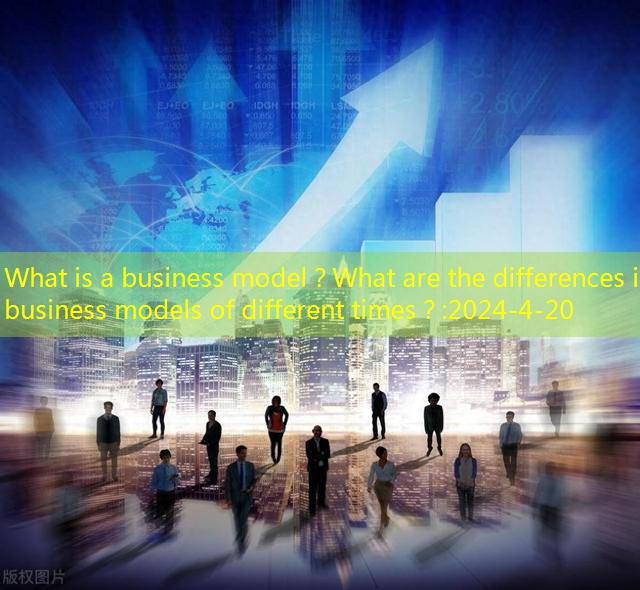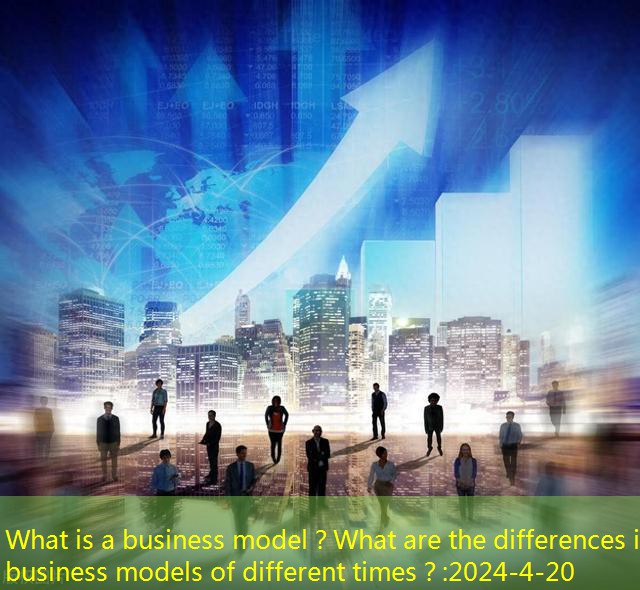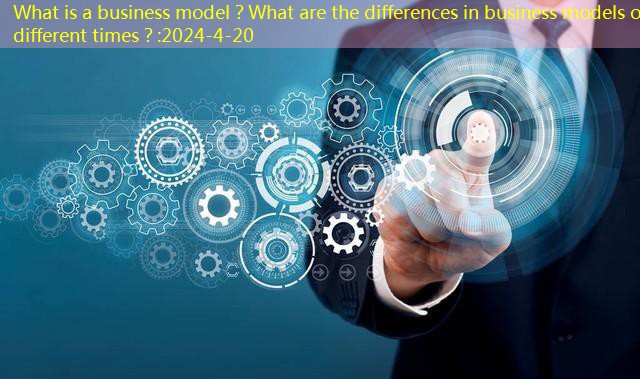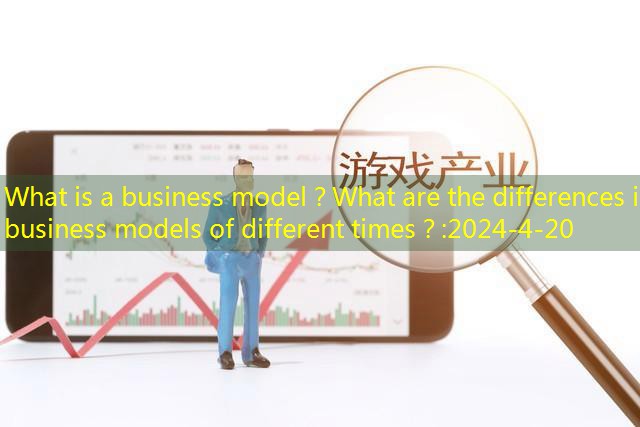
What is a business model?What are the differences in business models of different times?

The business model refers to the maximum value of all parties in order to achieve the value of all parties, integrate the internal and external elements that can make the company’s operation, form a complete, high -efficiency, and unique core competitive operation system, and through the optimal implementation form,Meet the overall solution of customers’ needs and realize customer value, and at the same time enable the system to achieve continuous profitability.It is a conceptual tool that contains a series of elements and its relationships to clarify the business logic of a specific entity.
There are significant differences in business models of different times, which originated from factors such as market demand, scientific and technological progress, social and cultural factors of various eras.Historically, the business model has experienced many innovations and changes. From 1673 to 1990, a variety of representative models and enterprises have emerged in business models.For example, Ford uses division of labor operations to achieve the scale of flowing water, leading the revolution of the manufacturing industry.With the changes of the times and the advancement of technology, the business model has also evolved and developed. From traditional business models to modern business models, many changes and changes have been experienced.In the Internet era, the differences between business models, operating models and profit models have become more obvious. The business model is the manifestation of how the enterprise realizes the value, and the operating model and profit model are concerned about how to play the corporate framework and help.Enterprises achieve more profits.
In addition, there are significant differences in the business models of different industries. These differences originated from the characteristics of various industries, market demand, competitive pattern, and value creation.For example, the business model of manufacturing usually involves production and sales of physical products, and the business model under the Internet economy may focus more on the value creation of digital platforms and community interaction.

Business model is a complex and dynamic concept. It has continued to evolve and innovate with the development of the times and the advancement of technology.Understanding and studying the business models of different eras and industries is of great significance for enterprises to formulate strategies, innovate, and adapt to market changes.
The early forms of the business model are mainly based on purchasing products or services directly from suppliers and selling them to the final consumers in the market.The advantage of this direct -operated model is that it can better control the supply chain and sales channels to ensure product quality and service quality.With the continuous changes in market and consumer demand, enterprises need to continuously update their business models to adapt to these changes and maintain competitiveness.The development of new business models can help companies get greater market share and increase income and profits.
In order to meet different market demand and technological progress, enterprises have adopted a variety of strategies.First of all, enterprises need to understand market demand and trend so that they can adjust their business models in a timely manner.The changes in market demand may be caused by technological progress, changes in consumer behavior, and the entry of competitors.Secondly, managers should pay close attention to changes in market dynamics and consumer needs, quickly respond and make corresponding adjustments.At the same time, innovation, technology applications, and interaction with consumers are also the key to adapting to changing markets and consumer needs.In addition, the key strategies for the new business model to adapt to market changes include closely paying attention to market trends and changes in consumer demand, flexibly adjusting business models, strengthening innovation capabilities, and establishing good organizational culture and teamwork.
In the face of the challenges of the modern market, companies also need to pass the transactions between the current stakeholders, and meet the needs of the existing products or services in a lower cost and efficient way to meet the needs of the current consumer market.The efficiency business model will focus on the needs of customers to expand the scale and scope economy.As a powerful engine of the new business revolution, scientific and technological innovation can not only create, excavate, guide and trigger new business needs, but also bring profound changes to business models, formats and profit models.Therefore, the coupling coordination relationship between technological innovation and business model innovation has an important impact on the profit and sustainable development of enterprises.

The early forms of business models and its ability to meet different market demand and technological progress are reflected in the way to directly purchase and sell to suppliers in the way of final consumers.With the changes in market and consumer demand, companies can adjust and optimize their business models by understanding market demand, rapid response, strengthening innovation capabilities, and establishing a good organizational culture to adapt to market changes and demand to achieveBusiness goals.
In the Internet era, the emerging business models representing the current market trend mainly include the sharing economy, O2O (Online To Office), and platform economy.Through the application of Internet technology, these models have a profound impact on the operation and profit model of enterprises.
The shared economic model, such as shared bicycles, online travel platforms, etc., is the product of the integration of the Internet and traditional industries, which has changed the competitive pattern of traditional industries.This model reduces the cost of consumer use by providing shared resources, and also brings new sources of income for service providers.
The O2O model, the combination of online service with offline experience, provides enterprises with new marketing channels and customer interaction methods.This model can help companies better understand customer needs and improve customer satisfaction and loyalty.
The platform economic model, through the construction of an open platform, connects both parties to supply and demand, promotes the free flow of information and the effective allocation of resources.This model not only expands the market scope of the enterprise, but also improves operating efficiency and profitability.
In addition, digital transformation, personalized services, online marketing, micro -profit management, etc. are also changes in future business models and profit models.Enterprises need to continuously innovate to adapt to market changes, strengthen technological innovation, expand the Internet market, and optimize management costs to cope with the challenges brought about by consumption upgrades.
Emerging business models in the Internet era have a significant impact on corporate operations and profit models by changing sales channels, promoting innovation -driven, expanding market expansion, and optimizing cost structures.Enterprises need to keep up with market trends, continue to innovate and adjust strategies to adapt to this era of change.

There are significant differences in business models between different industries, and these differences have changed with technological progress.The Internet economy and manufacturing are two representative industries. Their differences in business models are mainly reflected in the network effect, asset model, marketing method, distribution channels, and digital transformation.
One of the characteristics of the business model of the Internet economy is the strong network effect, that is, the more participants, the more the value of the network of the network increases in geometric levels, which provides high -quality soil for the growth of high barriers to monopoly enterprises.In addition, the Internet economy also adopts a light asset model. The capital investment required for scale expansion is close to zero. The scale economy is obvious, with high profit margins and unlimited limit.The new features of the industrial Internet era also include creating economic value through the integration of enterprises and the Internet, promoting the direct connection between production and consumption, reducing agency links, reducing costs, and improving efficiency.
In contrast, the business model innovation of the manufacturing industry is mainly reflected in the digitalization of marketing methods and flat distribution channels.With the advancement of technology, manufacturing companies have begun to attach importance to the impact of digital transformation on business model innovation, and digital transformation has a significant positive impact on business model innovation.The business model innovation of manufacturing enterprises also includes the use of 4P combination theory (products, prices, marketing, channels) for innovation of Internet business portfolio.In addition, changes in customer needs have also prompted some manufacturing industries to change the original large -scale production model, and to turn large -scale customized models that can meet consumers’ personalized needs.
With the advancement of technology, the business models of the Internet economy and manufacturing are constantly evolving.The Internet economy adapts to the rapidly changing market environment by strengthening the network effect and adopting light asset models.The manufacturing industry improves efficiency and meets consumers’ personalized needs through digital transformation and marketing methods.These changes not only reflect the impact of technological progress on the business model of enterprise, but also show the different adaptive strategies of different industries in the face of technological innovation.

In the innovation and change of business models, key factors include technological innovation, social and cultural changes, and changes in market demand.First of all, technological innovation is an important driving force to promote business model innovation.Studies have shown that there are three models: one -way driver, two -way driver and complex interaction between technological innovation and business model innovation. These synergy effects can drive enterprises to grow multi -dimensional.In addition, advanced technology solutions can promote the transformation of corporate value creation, that is, technology innovation will promote business model innovation.This shows that technological innovation is not only the basis of business model innovation, but also the key driving force for its development.
Social and cultural changes have also played a decisive role in innovative business models.Cultural change is considered the core of business model changes, which means that when the business model changes and transforms, they must first consider cultural change.This shows that changes in the internal culture and external environment of an enterprise are essential for the innovation of business models.
The changes in market demand are also a key factor affecting the innovation of business models.Managers need to understand market changes in depth and re -evaluate the business model based on these changes to provide differentiated products or services.This shows that enterprises must flexibly respond to changes in market demand and meet these changes through innovative business models, thereby gaining competitive advantages.
The changes in technological innovation, social and cultural changes, and market demand are the key decisive factor in business model innovation and change.These factors interaction have jointly promoted the innovation and development of business models.

Evaluating the effectiveness of a business model in a rapidly changing market environment requires comprehensive consideration of factors in multiple aspects.First of all, profitability is one of the important indicators to evaluate the effectiveness of the business model, which reflects whether the business model can continue to generate profits.Secondly, market demand analysis is also an indispensable part. It is necessary to study the needs of the target market and potential customer groups, and understand their needs, preferences and purchasing capabilities to determine whether the business model can meet the market demand.In addition, the analysis of competitive advantages is also very important. By analyzing competitors’ products, services, pricing strategies and market share, it can evaluate the competitive position of the business model.
In addition to the above factors, the sustainability of the business model is also an important consideration.This includes research and analysis of key factors such as market adaptability, reproduction and scalability.Business model innovation and market adaptability are considered to be a key factor in the success of enterprises, which means that companies need to continuously seek new ways to create and obtain value, while maintaining the sensitivity to market changes.
In terms of specific operations, financial data analysis, market research, SWOT analysis, value chain analysis, cost benefit analysis, and customer feedback can be evaluated.These methods can help companies understand all aspects of business models from different angles, so as to make more scientific and reasonable decisions.


